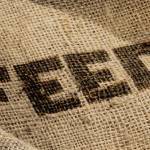Peanut Products in Horse Nutrition

Over 25,000 farmers cultivate peanuts throughout the southern United States. Crops grown in Georgia, Texas, and Alabama account for about 75% of the nation’s total yield. The United States exports nearly a quarter million metric tons of peanuts annually, yet two countries trump the United States in total production, China and India.1 As it turns out, peanuts are a big business. Although peanut production represents an important segment of agriculture in certain regions of the world, few by-products of the well-known legume are incorporated into high-quality horse feeds.
Once peanuts are harvested and cleaned, only one thing stands in the way of getting to the nut: the shell, of course. What do peanut processors do with all of those shells? In agricultural lingo, those shells are known as hulls. Over the years, researchers have investigated the use of peanut hulls as an ingredient in horse feeds, though results have proven disappointing, according to Kathleen Crandell, Ph.D., senior nutritionist at Kentucky Equine Research.
Nutritional analysis of peanut hulls reveals low levels of protein, fat, and minerals, and virtually no vitamins whatsoever. On the flip side, peanut hulls are rich in fiber, a dietary component that all horses require. A closer look reveals the fiber is mostly indigestible. Average statistics from multiple samples showed neutral detergent fiber (NDF) as 69% and acid detergent fiber (ADF) as 60%, according to Nutrient Requirements of Horses, published by the National Research Council.
“The high ADF compared to NDF indicates that there is a lot of lignin, an indigestible fiber, in hulls. In fact, there is about 22-24% lignin, which is really high. In contrast, hay is usually less than 10% lignin,” said Crandell.
Among equine nutritionists and some feed manufacturers, peanut hulls are considered filler. “Now, some horsemen might think that filler, especially a fibrous filler, would be appropriate, even beneficial, for obese ponies and horses, but that’s not true. Other than being almost entirely empty of useful nutrients, peanut hulls could be contaminated with aflatoxins, which are poisonous to horses,” Crandell stressed. “Plus,” she added, “reputable feed manufacturers avoid using fillers of any type.”
Extracted from shelled and crushed nuts, peanut oil represents just one value-added product from the peanut industry. Peanut oil is prized by cooks because it withstands high frying temperatures. Due to its cost compared to other vegetable oils, peanut oil has not gained a foothold in the equine market, though there is no reason to believe that horses could not benefit from it just as they do from other liquid fats, said Crandell.
Because peanuts grow beneath the soil surface, some people mistakenly believe that peanut hay is made from the leafy plant tops left after peanut harvesting. Hay made from this stubble would likely be unpalatable because the plants would be extremely mature by the time the peanuts ripened. On the contrary, peanut hay is not a by-product at all. Instead, it is a special peanut plant grown exclusively for forage production, and is classified as a legume, like alfalfa (lucerne) and clover.
According to Crandell, the popularity of peanut hay has risen over the last several years. “Horses love it, probably because it has a taste similar to other legumes. Plants have large leaves, compared to alfalfa, so there is less of a problem with leaf shatter.”
Peanut hay generally does not have the bright green appearance of high-quality alfalfa, so some horsemen question its nutritive value, but Crandell corrects this misassumption. “Peanut hay doesn’t look terribly appealing because it is often brownish or yellowish, but it doesn’t seem as though horses mind the color.”
Because of its palatability, overconsumption can be a problem for many horses, just as free-choice alfalfa can be. As always, work with a professional equine nutritionist to determine how best to use peanut hay in a nutrition management program.
1American Peanut Council. Accessed March 20, 2015.








